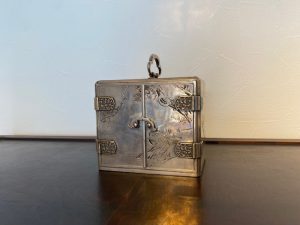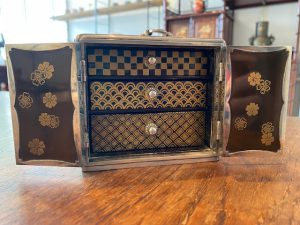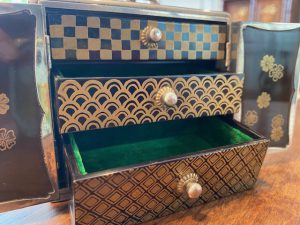日本古来の模様の美しさ(愛知県名古屋市千種区姫池通 古美術風光舎 名古屋店 骨董買取いたします)
2021.11.09
みなさま、こんにちは。
最近、着物を着るようになって日本古来の模様にとても興味を持っているスタッフmです。
着物の勉強を我流でやり始めたばかりなので、そこは興味のあることしか頭に入ってこないのでありますが…。
先日、我が家の食卓で「市松文様とは」という話になりました。
息子がテレビを見ながら、「このチェック模様ってかっこいいよね。」というようなことを言っていたので
「それって市松文様って言って、日本古来の模様なんだよ。」と私が申しますと、
「え、これ、日本に昔からある模様なんだ?!」と驚いていました。
そこで、一世を風靡したアニメ『鬼滅の刃』の主人公、竈門炭治郎が来ている羽織の模様が、緑と黒の正方形を互い違いに並べたチェック模様の市松模様であるこったことを思い出させると、「確かにね!」と納得の様子。
でも、なぜ市松模様というのかは知らなかったので、さっそく調べてみました。
すると、それまでは「石畳」もしくは「霰(あられ)」と呼ばれていましたが、江戸時代に佐野市松という歌舞伎役者がこの柄の袴を身に着けていたため「市松模様」と呼ばれるようになったようです。
なるほど!
チェック柄に自分の名前がついてしまうとは、イギリスのタータンチェックのようでかっこいいですね。(ちょっと違いますかね…。)(笑)

なぜ、模様の話題を出したのかというと、今日インスタグラム用に写真撮影していた金工作品の『銀宝箱』がとても素敵だったからなんです。
こちらの宝箱、手のひらにすっぽり収まるサイズのものですが、観音開きの扉を開けると、中から小さな引き出しが出てきます。
3段ある引き出しの模様がすべて違う模様で描かれていて、その細工の細かさにただただうっとりしてしまうんです。
それが、こちら。

三段の引き出しの一番上は「市松文様」です。
同じ柄がどこまでも途切れることなく続く様子から「子孫繁栄」「事業拡大」の意味があるそうです。
この引き出しの内側には緑のベルベットが丁寧に敷かれていて、大切な指輪などのジュエリーをしまっていたのかしら、と想像してしまいます。

真ん中の段は「青海波(せいがいは)文様」です。
穏やかな波を描いた模様で、どこまでも続く波模様には「未来永劫穏やかに暮らしていけるように」という願いが込められていて、結婚祝いにもつかわれるそうです。
この模様、以前飛騨高山に旅行したときに、陣屋のお庭でも目にしました。
その時は母と一緒だったのですが、母が「青海波砂紋だね。」と言っていて、私はその時初めてその模様の名前を知りました。
庭に池や水の代わりに砂や小石を敷き、その表面の砂にほうきなどで波などの模様を描いたもので、枯山水と呼ばれる庭園で使われる技法のようです。
一番下は「鹿の子文様」でしょうか。
鹿の子とはその名の通り、小鹿の背中のまだら模様に似ていることに由来します。
鹿は神の使いとも言われ、縁起の良い動物であり、また生命力や繁殖力に優れることから「子孫繁栄」の象徴として用いられています。
また、絞り染めでは、生地を少しだけつまんで糸を縛り、染料につけて糸をほどくという大変手間のかかる技法で作られる文様のため、総鹿の子絞りの着物は贅沢品とされていました。
そして、扉の裏には桜の花が描かれています。
桜文様は、寒い冬を越え、春の訪れを告げる花であることから「物事の始まり」を意味する模様です。
また、かつて花見は五穀豊穣を願うための行事だったことから「豊かさ」を、一斉にたくさんの花を咲かせることから「繁栄」を表したようです。
このように、縁起の良いとされる日本伝統の和柄を「吉祥文様(きっしょうもんよう)」と呼ぶのですが、それらが内側に散りばめられたこの「銀宝箱」。
ご結婚のお祝いに贈られたものなのでしょうかね。
扉を開けると、物事の始まりを桜で表現し、市松文様で子孫繁栄を、青海波で未来永劫穏やかに暮らしていかれることを、鹿の子文様でも子孫繁栄への願いを込められているのだと思います。
頂いた方はとても大切にされたのだと思います。
昭和初期のお品ながら、輝きはまだまだ失われていません。
是非ごらんになってくださいませ。
(スタッフm)
Hello everyone.
Recently, I’m a staff member who has come to wear kimono and is very interested in ancient Japanese patterns.
I’ve just started studying kimono in my own way, so I’m only interested in what I’m interested in …
The other day, at my dining table, I talked about “What is a checkered pattern?”
His son was watching TV and said something like “This checkered pattern is cool.”
“That’s the checkered pattern, which is an ancient Japanese pattern,” I said.
I was surprised, “Well, this seems to have been in Japan for a long time ?!”
So, I remember that the haori pattern that Tanjiro Kamado, the main character of the anime “Kimetsu no Yaiba”, which prevailed in the world, came was a checkered checkered pattern in which green and black squares were arranged alternately. When I let him do it, he seemed to be convinced, “Sure!”
But I didn’t know why it was a checkered pattern, so I looked it up right away.
Then, until then, it was called “stone pavement” or “hail”, but in the Edo period, a Kabuki actor named Sano Ichimatsu wore a hakama with this pattern, so it was called “checkerboard pattern”. It seems that it became.
So that’s it!
It’s cool like a British tartan check that your name is attached to the plaid. (Is it a little different …) (laughs)
The reason why I talked about patterns is that the metalwork work [Silver Treasure Box] that I was taking pictures for Instagram today was very nice.
This treasure chest fits comfortably in the palm of your hand, but when you open the double door, a small drawer comes out from inside.
The patterns of the three drawers are all drawn in different patterns, and I’m just fascinated by the fineness of the work.
That is here.
The top of the three-tiered drawer is the “checkerboard pattern”.
It seems that there is a meaning of “prosperity of descendants” and “business expansion” from the appearance that the same pattern continues forever without interruption.
The inside of this drawer is carefully laid with green velvet, and I wonder if it was storing precious rings and other jewelry.
The middle row is the “Seigaiha pattern”.
It is a pattern that depicts a gentle wave, and the wave pattern that continues forever contains a wish to “live calmly in the future”, and it is said that it is also used as a wedding gift.
I saw this pattern in the garden of Jinya when I traveled to Hida Takayama before.
I was with my mother at that time, but her mother said, “It’s a Qinghai wave sand crest.” I knew the name of the pattern for the first time.
Instead of ponds and water, sand and pebbles are laid in the garden, and patterns such as waves are drawn on the sand on the surface with a broom, which seems to be a technique used in the garden called dry landscape garden.
Is the bottom “Kanoko pattern”?
As the name suggests, Kanoko is derived from the fact that it resembles a mottled pattern on the back of a fawn.
The deer is also said to be a messenger of the gods, is an auspicious animal, and is used as a symbol of “prosperity of offspring” because of its excellent vitality and fertility.
Also, in tie-dyeing, the kimono of Sokanoko squeezing was regarded as a luxury item because it is a pattern made by a very time-consuming technique of pinching the fabric a little, tying the thread, soaking it in the dye and unwinding the thread.
And the cherry blossoms are drawn on the back of the door.
The cherry blossom pattern seems to mean “the beginning of things” because it is a flower that heralds the arrival of spring after the cold winter.
In addition, it seems that cherry-blossom viewing used to represent “richness” because it was an event to wish for a good harvest, and “prosperity” because many flowers bloomed all at once.
In this way, traditional Japanese patterns that are said to be auspicious are called “Kishomonyo”, and these “silver treasure chests” are studded inside.
Is it a gift given to the wedding celebration?
When the door is opened, the beginning of things is expressed by cherry blossoms, the checkered pattern is used to prosper the descendants, and the Qinghai wave is used to live calmly in the future. think.
I think that the person who received it was very important.
Although it is an item from the early Showa period, its brilliance has not yet been lost.
Please take a look.
**********************
少しお寒くなってまいりました。冬物の入れ替えや、整理をされていらっしゃる方もおいでではないでしょうか。
生活様式の変化とともに、大切なお品を整理されている方も多いことと思われます。
ここ風光舎では、古美術品や骨董品の他にも絵画や宝石、趣味のお品など様々なジャンルのものを買受しております。
お片付けをされていて、こういうものでもいいのかしらと迷われているものでも、どうぞお気軽にご相談下さいませ。
風光舎は、出張買取も強化しております。
愛知県内はもちろん、岐阜県・三重県その他の県へも出張いたします。
どんなにご近所の方でもお伺いできますので、まずはお電話お待ちしております。
愛知県名古屋市千種区・骨董 買取
『古美術 風光舎 名古屋店』
TEL 052(734)8444
10:00-17:00 OPEN

